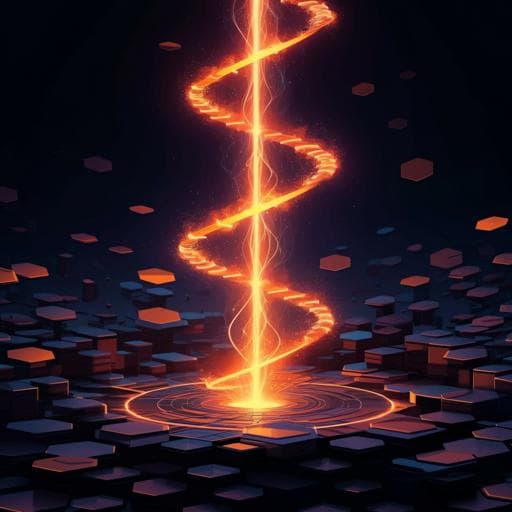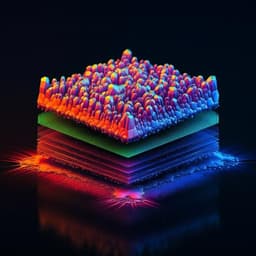
Physics
Light helicity detector based on 2D magnetic semiconductor CrI3
X. Cheng, Z. Cheng, et al.
Discover groundbreaking research on light helicity detectors using graphene-CrI3-graphene heterostructures. The team explored the influence of CrI3's magnetic state on optoelectronic properties, unveiling unique photocurrent behaviors that could revolutionize spin-optoelectronic devices.
~3 min • Beginner • English
Introduction
Since the discovery of intrinsic ferromagnetism in 2D van der Waals crystals (e.g., CrI3) in 2017, two-dimensional magnetic semiconductors have emerged as a platform to explore magneto-optical and magneto-electronic phenomena at the atomic limit and to enable magneto-optoelectronic devices. Monolayer CrI3 is ferromagnetic while multilayer CrI3 exhibits layered antiferromagnetism with an out-of-plane easy axis. Prior studies established strong coupling between magnetic order and optical/electronic responses (e.g., helical luminescence, tunneling magnetoresistance, electrostatic control). The present work aims to understand and exploit the interplay between magnetic order and optoelectronic response in CrI3 by building graphene–CrI3–graphene heterostructures that act as light helicity detectors. The central questions are whether and how the photocurrent depends on light helicity and magnetic state, how this correlates with RMCD, and what mechanisms underlie any anomalous photocurrent behaviors at higher bias.
Literature Review
The study builds on foundational observations of 2D magnetism in CrI3 and related vdW magnets (Gong et al., Huang et al.). Prior magneto-transport work showed large tunneling magnetoresistance in CrI3 spin-filter junctions (Song et al.; Klein et al.; Wang et al.), and magnetism can be tuned by electrostatic doping (Jiang et al.). Optical studies reported ligand-field helical luminescence and strong excitonic/magneto-optical responses in monolayer CrI3 with helicity-selective optical selection rules (Seyler et al.; Wu et al.). Theoretical and experimental works highlighted spin filtering and spin-dependent bandgaps in CrI3 (Paudel & Tsymbal; Li et al.). Methodological frameworks for analyzing tunneling regimes (direct vs Fowler–Nordheim tunneling) are referenced (Beebe et al.; Ikuno et al.; Lenzlinger & Snow; Simmons). Helicity detection concepts in other materials are also cited (Rinaldi et al.; Zamani & Farghadan).
Methodology
- Devices: Graphene–CrI3–graphene vertical heterostructures encapsulated in hBN (10–30 nm) were fabricated by mechanical exfoliation and dry transfer on Si/SiO2 in an argon glove box (<0.1 ppm O2 and H2O). The stack was assembled layer-by-layer using PDMS as a stamp under a microscope with micromanipulation. Graphene top/bottom electrodes were contacted to pre-patterned Cr/Au (5/25 nm). Flake thicknesses were estimated optically and confirmed by AFM after measurements. Devices included monolayer (D1) and multilayer (∼10–14 nm, D2, D3) CrI3.
- Measurement conditions: Experiments were performed in a dry cryostat (attoDRY2100, base 1.7 K) with a 9 T superconducting magnet. Unless specified: T = 2 K, excitation wavelength 633 nm (He–Ne), power 10 μW, beam diameter ∼1 μm. Both the incident beam and magnetic field μ0H were normal to the layers (parallel to the CrI3 easy axis).
- RMCD: Defined as (Rσ+ − Rσ−)/(Rσ+ + Rσ−). The laser was modulated by a chopper and photoelastic modulator, focused with an LT-APO objective; reflected light was collected to a PMT with lock-in detection.
- Magneto-optoelectronic photocurrent: Circular polarization was produced with a polarizer and a quarter-wave plate on a motorized rotation stage; light was chopped at 73 Hz; photocurrent measured by lock-in. I–V curves were taken with a Keithley 2636B.
- Monolayer protocol: D1 was first magnetized at |μ0H| > 0.3 T. Helicity-resolved light-on current Ilight was measured at μ0H = 0 for σ+ and σ−; ΔI = Ilight+ − Ilight− vs bias was recorded. Power dependence and bias dependence were acquired; photoresponsivity R = Iph/P with Iph = Ilight − Idark; helicity contrast ρ = (R+ − R−)/(R+ + R−). For field dependence, Iph (V = 0.15 V) was measured while sweeping μ0H between ±0.3 T; the quarter-wave plate angle was scanned and cosine fits yielded ρ.
- Multilayer protocol: For D2 (14 nm), RMCD and ρ were measured while sweeping μ0H between −3.5 and +3.5 T. To suppress dark tunneling contributions, photocurrent was measured at V = −0.15 V (regime where Idark is negligible up to |V| ≈ 0.19 V). Magnetoresistance and Idark–V characteristics were also recorded.
- Negative photocurrent analysis: For D3 (~10 nm) at μ0H = 3 T, I–V under σ+ excitation (0–100 μW) was measured; Iph = Ilight − Idark extracted. Iph–V was linearly fit within |V| ≤ 0.15–0.19 V to obtain photoconductive current Ipc; ΔI = Iph − Ipc isolated illumination-induced change in tunneling. Idark mechanisms were examined by plotting log(I/V^2) vs 1/V to distinguish direct vs Fowler–Nordheim (FN) tunneling. Temperature dependence of |ΔI|/I at fixed bias and of Idark and Iph–V was measured from 2 K upward.
Key Findings
- Helicity-selective photocurrent in monolayer CrI3: After full magnetization, ΔI = Ilight+ − Ilight− vs bias shows opposite slope for up vs down magnetized states, evidencing helicity dependence. Photoresponsivity polarization ρ ≈ −6% (up) and +6% (down) at μ0H = 0 T, independent of excitation power (0–40 μW) at V ≈ 0.2 V.
- Magnetic-field correlation (monolayer): Sweeping μ0H between −0.3 and +0.3 T switches the sign of helicity preference with spin-flip transitions at ±0.1 T. ρ toggles between +6% and −6%; RMCD changes between −1% and +1%. Dark current is nearly field-independent.
- Temperature dependence (monolayer): Under zero-field cooling, ρ rises from 0% (80 K) to ~6% at 2 K, fitting ρ(T) = ρ0[1 − (T/Tc)^β] with Tc ≈ 40 K (close to reported monolayer CrI3 Curie temperature 45 K). Helicity response vanishes above ~40 K.
- Multilayer CrI3 (14 nm) shows layered AFM behavior: RMCD and ρ(μ0H) exhibit five plateaus as μ0H sweeps −3.5 to +3.5 T, reflecting discrete spin configurations. ρ = 0 at μ0H = 0 T (AFM ground state) and saturates at ±4.5% for |μ0H| > 2.2 T (fully spin-polarized). RMCD saturates at about ±10%.
- Abnormal negative photocurrent at higher bias: In ~10 nm device D3, I–V is linear for |V| ≤ ~0.19 V; at higher bias, light-on I–V curves become nonlinear and cross, causing Iph to decrease with increasing light power (negative photocurrent). In monolayer D1, similar behavior appears at V > ~0.25 V.
- Origin linked to tunneling regime: ΔI (illumination-induced change in tunneling) is negative at higher bias (|V| > ~0.19–0.25 V) and its magnitude |ΔI| scales with Idark; normalized ΔI–V overlaps normalized Idark–V, indicating ΔI ∝ Idark. log(I/V^2) vs 1/V reveals a transition from direct tunneling at low bias to Fowler–Nordheim tunneling at high bias (monolayer: FN above ~0.25 V; ~10 nm D3: FN above ~0.19 V). Negative photocurrent coincides with the FN regime.
- Temperature dependence of negative photocurrent: |ΔI|/I at V = −0.25 V (100 μW) decreases monotonically with temperature and vanishes above ~60 K, near the multilayer CrI3 Tc ≈ 61 K. As T increases, Idark shows a minimum around 60 K and Iph–V curves become linear, consistent with weakening negative photocurrent.
- Mechanistic picture: Helicity dependence arises from spin-split band structure and helicity-selective excitonic absorption (different σ+ vs σ− absorbance near 1.96 eV). Negative photocurrent is attributed to light-induced reduction of tunneling current at high fields, possibly via defect-related carrier trapping under FN tunneling.
Discussion
The experiments directly link the photocurrent helicity contrast to the magnetic state of CrI3. In monolayer devices, the sign and magnitude of ρ track field-driven spin flips and coincide with RMCD, consistent with helicity-selective optical transitions between spin-polarized bands and bright excitons. In multilayers, the plateau structure in both RMCD and ρ reflects discrete spin configurations of the layered AFM, demonstrating that the optoelectronic helicity response encodes the magnetic order. The anomalous negative photocurrent at high bias is explained by a reduction in tunneling current under illumination in the Fowler–Nordheim regime, with ΔI scaling with Idark and diminishing with temperature; a plausible microscopic origin is light-induced defect trapping that suppresses conduction-band-assisted tunneling. Collectively, the results establish a robust interplay between magnetism and optoelectronics in CrI3 and validate graphene–CrI3–graphene junctions as helicity detectors whose response can be tuned by magnetic field and temperature.
Conclusion
Graphene–CrI3–graphene vdW heterostructures function as light helicity detectors whose photoresponse is governed by the magnetic state of CrI3. Monolayer devices exhibit a helicity contrast ρ switching between ±6% with magnetic field (spin flips at ±0.1 T) and vanishing above ~40 K. Multilayer devices display AFM signatures with multiple ρ plateaus and saturation at ±4.5% for |μ0H| > 2.2 T (RMCD ~±10%). An anomalous negative photocurrent emerges at higher bias coincident with the Fowler–Nordheim tunneling regime; ΔI scales with Idark and weakens with increasing temperature, disappearing above ~60 K. These findings elucidate the coupling between magnetic order and helicity-dependent optoelectronics in CrI3 and point toward spin-optoelectronic device applications. Future work should probe the dynamics of photon–electron interactions and defect trapping to fully verify the mechanism behind the negative photocurrent and explore pathways for higher-temperature operation.
Limitations
- The helicity-dependent photoresponse in monolayer CrI3 vanishes above ~40 K, limiting operation near cryogenic temperatures; the negative photocurrent effect in multilayers disappears above ~60 K.
- The proposed mechanism for negative photocurrent (light-induced defect trapping under FN tunneling) is plausible but not fully verified; further dynamic studies are needed.
- Measurements are performed at low temperatures with small optical spots and specific bias regimes; generalizability to room temperature or different device geometries is not demonstrated.
Related Publications
Explore these studies to deepen your understanding of the subject.







